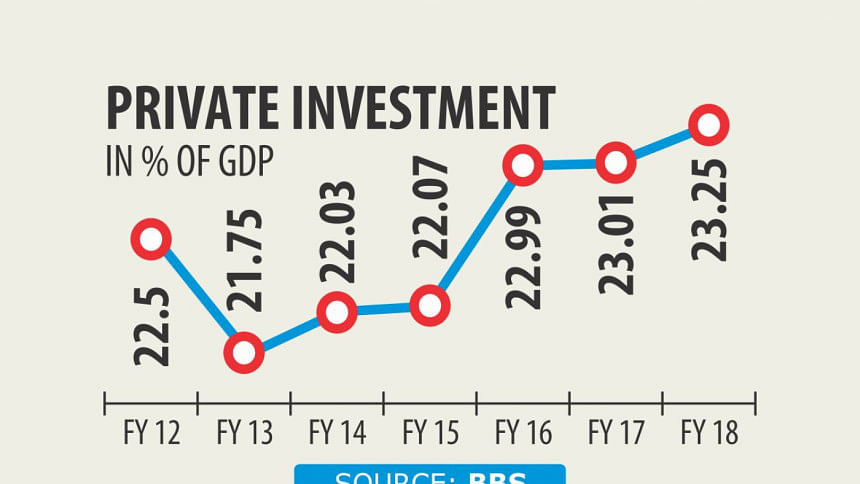Stagnant private investment a big headache

Private investment, job creation and narrowing income inequality are the major challenges for the country between 2018-19 and 2020-21, according to the government's medium-term macroeconomic policy statement.
Besides, the economy's structural transformation into one dependent on the manufacturing sector and bringing in discipline in the financial sector are also needed to attain the targeted level of development.
There are external tensions too: oil and commodity prices are on the rise and exports are not growing fast enough.
“We don't see any measures to meet these medium-term challenges in the budget,” said MK Mujeri, a former director general of the Bangladesh Institute of Development Studies.
Private investment is a major issue for the economy: it has been about 23 percent of the GDP for the last several years.
“To create jobs and sustainable growth we have to ensure massive private investment. But it is almost stagnant now,” Mujeri said.
Attracting adequate foreign direct investment (FDI) also remains an insurmountable task despite the ease of regulatory framework.
“Unfavourable business climate is the main reason behind the low investment in the country,” Mujeri added.
By 2021, the government aims to raise private investment-to-GDP ratio 26.1 percent to achieve the targeted growth rate and employment.
“The government must ensure an investment-friendly environment to bump up private investment,” said Selim Raihan, a professor of the University of Dhaka's economics department.
To ensure a favourable environment and lower the cost of doing business, the government will build 100 special economic zones as soon as possible. It is also implementing 10 mega infrastructure projects and formulating one-stop service for entrepreneurs.
As a result, public investment is soaring every year. However, it is not having any effect on private investment as the quality of government investment is very shoddy.
“Mismanagement in the implementation of the annual development programme in the last few months of a fiscal year leads to poor quality output, which is just not good enough to raise private investment,” Raihan said.
The Centre for Policy Dialogue (CPD) also emphasised quality infrastructure.
The think-tank said private investment would jump if the government implements the mega projects within the stipulated time and ensures quality ADP implementation.
Creating sufficient decent jobs for the growing labour force has become another key challenge for the government as every year about 20 lakh youths enter the job market, according to the policy statement. Bangladesh needs to look beyond the garment sector and diversify its export basket to create more and better jobs opportunities, it said.
There is no indication in the budget that the government is working to create quality jobs, Mujeri said. “People want to see measures.”
One way the government can create jobs is by expanding the cottage, micro, small and medium-sized enterprises. The sector could offer decent income opportunities if a better business environment can be ensured through removal of regulatory barriers and enhanced access to finance.
The outflow of workers will also reduce the pressure on the domestic job market.
This could be done through the diplomatic channel as well as reducing the cost of migration, easing the migration process and providing skills development programmes. Now, most of the incremental labour force is being absorbed into the low productive agriculture and informal sectors.
“In this backdrop, concerted effort will be there to enhance the share of the manufacturing sector to ensure massive employment generation,” said the policy statement.
When an economy moves forward, it is most desirable that the manufacturing sector's growth substantially surpasses the growth in the agriculture sector to help consolidate and sustain the growth momentum, it said. The share of agriculture in the GDP is declining, while the share of the industry is rising. The share of the services sector though remains relatively stable.
Yet, the contribution of the industry to the GDP has not matched its contribution to job creation as 40 percent of the labour force is still employed in the agriculture sector.
Income inequality remains a key challenge even though poverty is reducing.
Bangladesh's Gini coefficient, which is the gauge of economic inequality, increased from 0.41 in 2010 to 0.48 in 2016. The coefficient ranges from 0 (or 0 percent) to 1 (or 100 percent), with 0 representing perfect equality and 1 representing perfect inequality.
Furthermore, the income share of the lowest 10 percent of the households has declined from 2 percent in 2010 to 1.01 percent in 2016.
Another pressing task in the medium-term is to bring in discipline in the financial sector, given the current high non-performing loan ratio, capital inadequacy in some banks and the high interest rate on lending. Moreover, the capital market has not developed yet that it could serve as a solid alternative for raising funds.

 For all latest news, follow The Daily Star's Google News channel.
For all latest news, follow The Daily Star's Google News channel. 



Comments